University Nursing Research Report: Music Therapy for Pain Reduction
VerifiedAdded on 2023/04/05
|10
|1315
|81
Report
AI Summary
This nursing research report investigates the effect of music therapy on pain reduction in post-operative caesarean section patients. The research question was formulated using the PICOT framework, comparing music therapy to oral analgesia. The report outlines the search strategy, including keywords, synonyms, Boolean operators, and inclusion/exclusion criteria. Two databases, Cochrane Library and PubMed/Medline, will be used for literature search. A PRISMA flow diagram is included to visualize the search process, screening, and selection of articles. The report emphasizes peer-reviewed articles and limits the study to Western countries. The aim is to determine the effectiveness of music therapy as a non-pharmacological intervention for pain management in post-operative care.
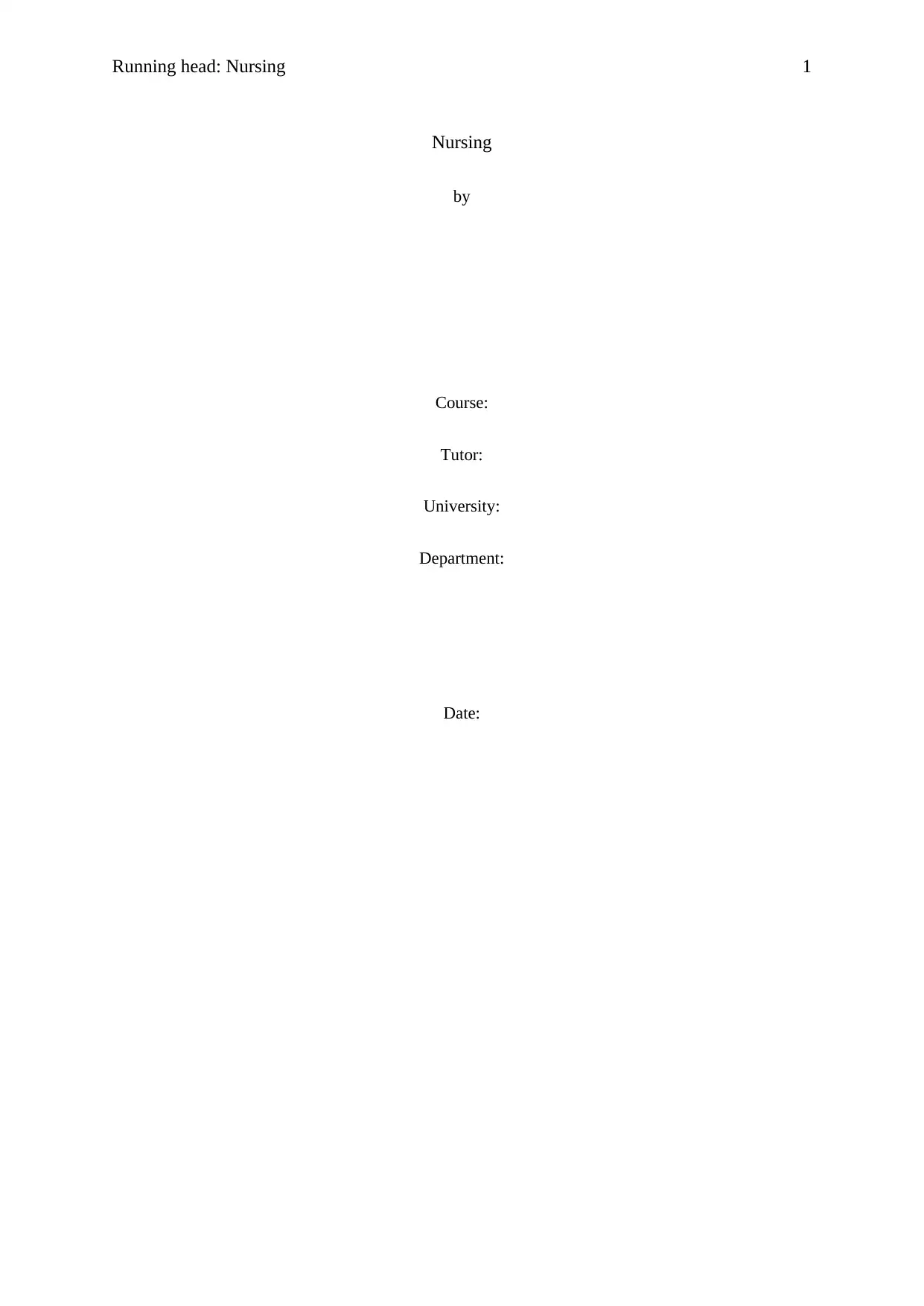
Running head: Nursing 1
Nursing
by
Course:
Tutor:
University:
Department:
Date:
Nursing
by
Course:
Tutor:
University:
Department:
Date:
Paraphrase This Document
Need a fresh take? Get an instant paraphrase of this document with our AI Paraphraser
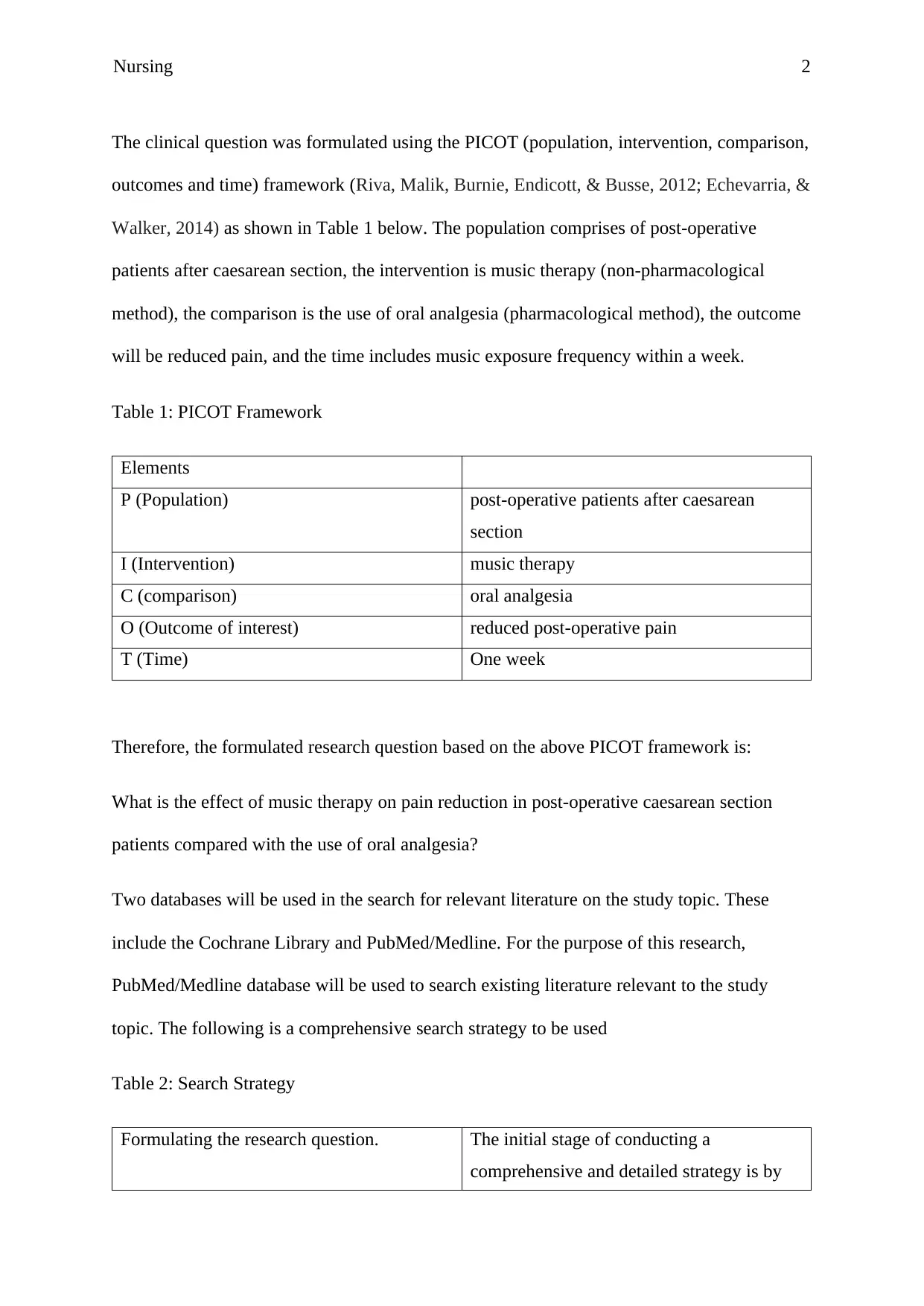
Nursing 2
The clinical question was formulated using the PICOT (population, intervention, comparison,
outcomes and time) framework (Riva, Malik, Burnie, Endicott, & Busse, 2012; Echevarria, &
Walker, 2014) as shown in Table 1 below. The population comprises of post-operative
patients after caesarean section, the intervention is music therapy (non-pharmacological
method), the comparison is the use of oral analgesia (pharmacological method), the outcome
will be reduced pain, and the time includes music exposure frequency within a week.
Table 1: PICOT Framework
Elements
P (Population) post-operative patients after caesarean
section
I (Intervention) music therapy
C (comparison) oral analgesia
O (Outcome of interest) reduced post-operative pain
T (Time) One week
Therefore, the formulated research question based on the above PICOT framework is:
What is the effect of music therapy on pain reduction in post-operative caesarean section
patients compared with the use of oral analgesia?
Two databases will be used in the search for relevant literature on the study topic. These
include the Cochrane Library and PubMed/Medline. For the purpose of this research,
PubMed/Medline database will be used to search existing literature relevant to the study
topic. The following is a comprehensive search strategy to be used
Table 2: Search Strategy
Formulating the research question. The initial stage of conducting a
comprehensive and detailed strategy is by
The clinical question was formulated using the PICOT (population, intervention, comparison,
outcomes and time) framework (Riva, Malik, Burnie, Endicott, & Busse, 2012; Echevarria, &
Walker, 2014) as shown in Table 1 below. The population comprises of post-operative
patients after caesarean section, the intervention is music therapy (non-pharmacological
method), the comparison is the use of oral analgesia (pharmacological method), the outcome
will be reduced pain, and the time includes music exposure frequency within a week.
Table 1: PICOT Framework
Elements
P (Population) post-operative patients after caesarean
section
I (Intervention) music therapy
C (comparison) oral analgesia
O (Outcome of interest) reduced post-operative pain
T (Time) One week
Therefore, the formulated research question based on the above PICOT framework is:
What is the effect of music therapy on pain reduction in post-operative caesarean section
patients compared with the use of oral analgesia?
Two databases will be used in the search for relevant literature on the study topic. These
include the Cochrane Library and PubMed/Medline. For the purpose of this research,
PubMed/Medline database will be used to search existing literature relevant to the study
topic. The following is a comprehensive search strategy to be used
Table 2: Search Strategy
Formulating the research question. The initial stage of conducting a
comprehensive and detailed strategy is by
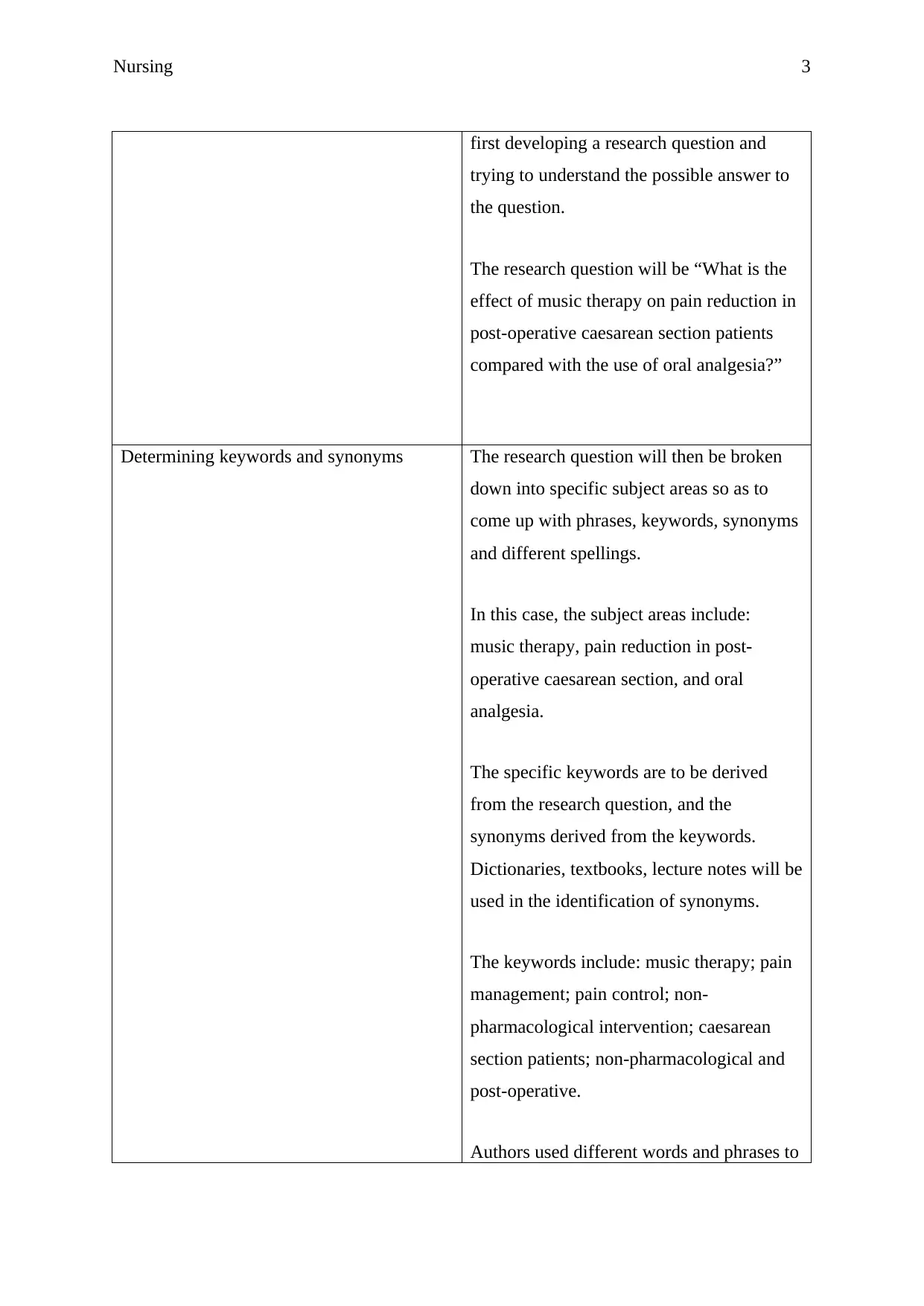
Nursing 3
first developing a research question and
trying to understand the possible answer to
the question.
The research question will be “What is the
effect of music therapy on pain reduction in
post-operative caesarean section patients
compared with the use of oral analgesia?”
Determining keywords and synonyms The research question will then be broken
down into specific subject areas so as to
come up with phrases, keywords, synonyms
and different spellings.
In this case, the subject areas include:
music therapy, pain reduction in post-
operative caesarean section, and oral
analgesia.
The specific keywords are to be derived
from the research question, and the
synonyms derived from the keywords.
Dictionaries, textbooks, lecture notes will be
used in the identification of synonyms.
The keywords include: music therapy; pain
management; pain control; non-
pharmacological intervention; caesarean
section patients; non-pharmacological and
post-operative.
Authors used different words and phrases to
first developing a research question and
trying to understand the possible answer to
the question.
The research question will be “What is the
effect of music therapy on pain reduction in
post-operative caesarean section patients
compared with the use of oral analgesia?”
Determining keywords and synonyms The research question will then be broken
down into specific subject areas so as to
come up with phrases, keywords, synonyms
and different spellings.
In this case, the subject areas include:
music therapy, pain reduction in post-
operative caesarean section, and oral
analgesia.
The specific keywords are to be derived
from the research question, and the
synonyms derived from the keywords.
Dictionaries, textbooks, lecture notes will be
used in the identification of synonyms.
The keywords include: music therapy; pain
management; pain control; non-
pharmacological intervention; caesarean
section patients; non-pharmacological and
post-operative.
Authors used different words and phrases to
⊘ This is a preview!⊘
Do you want full access?
Subscribe today to unlock all pages.

Trusted by 1+ million students worldwide

Nursing 4
describe given subject areas. Therefore, this
necessitates the use of synonyms alongside
keywords in the search strategy so as to
avoid missing any important research.
The examples of synonyms include:
Music therapy; music therap$, therapeutic
musi$
Pain reduction – pain reduction$, pain
managemen$, pain contro$
Post-operative – post operativ$,
Caesarean section- Caesarean section$
Words such as the, a, an, in, or, of etc will
not be used alongside the keywords or
synonyms during the research.
Boolean operators Once, all the synonyms, keywords and
phrases have been identified, the Boolean
operators ‘AND’, ‘OR’ and ‘NOT’ will be
used to combine the subject areas (Hammer,
& Rudeanu, 2012; Orcher, 2016).
The use of ‘OR’
The OR operator will be used to combine all
the individual synonym searches together
into a single search. For instance,
Music therapy - ‘Music therap$’ OR
‘therapeutic musi$’
Pain reduction – ‘pain reduction$’ OR ‘pain
describe given subject areas. Therefore, this
necessitates the use of synonyms alongside
keywords in the search strategy so as to
avoid missing any important research.
The examples of synonyms include:
Music therapy; music therap$, therapeutic
musi$
Pain reduction – pain reduction$, pain
managemen$, pain contro$
Post-operative – post operativ$,
Caesarean section- Caesarean section$
Words such as the, a, an, in, or, of etc will
not be used alongside the keywords or
synonyms during the research.
Boolean operators Once, all the synonyms, keywords and
phrases have been identified, the Boolean
operators ‘AND’, ‘OR’ and ‘NOT’ will be
used to combine the subject areas (Hammer,
& Rudeanu, 2012; Orcher, 2016).
The use of ‘OR’
The OR operator will be used to combine all
the individual synonym searches together
into a single search. For instance,
Music therapy - ‘Music therap$’ OR
‘therapeutic musi$’
Pain reduction – ‘pain reduction$’ OR ‘pain
Paraphrase This Document
Need a fresh take? Get an instant paraphrase of this document with our AI Paraphraser
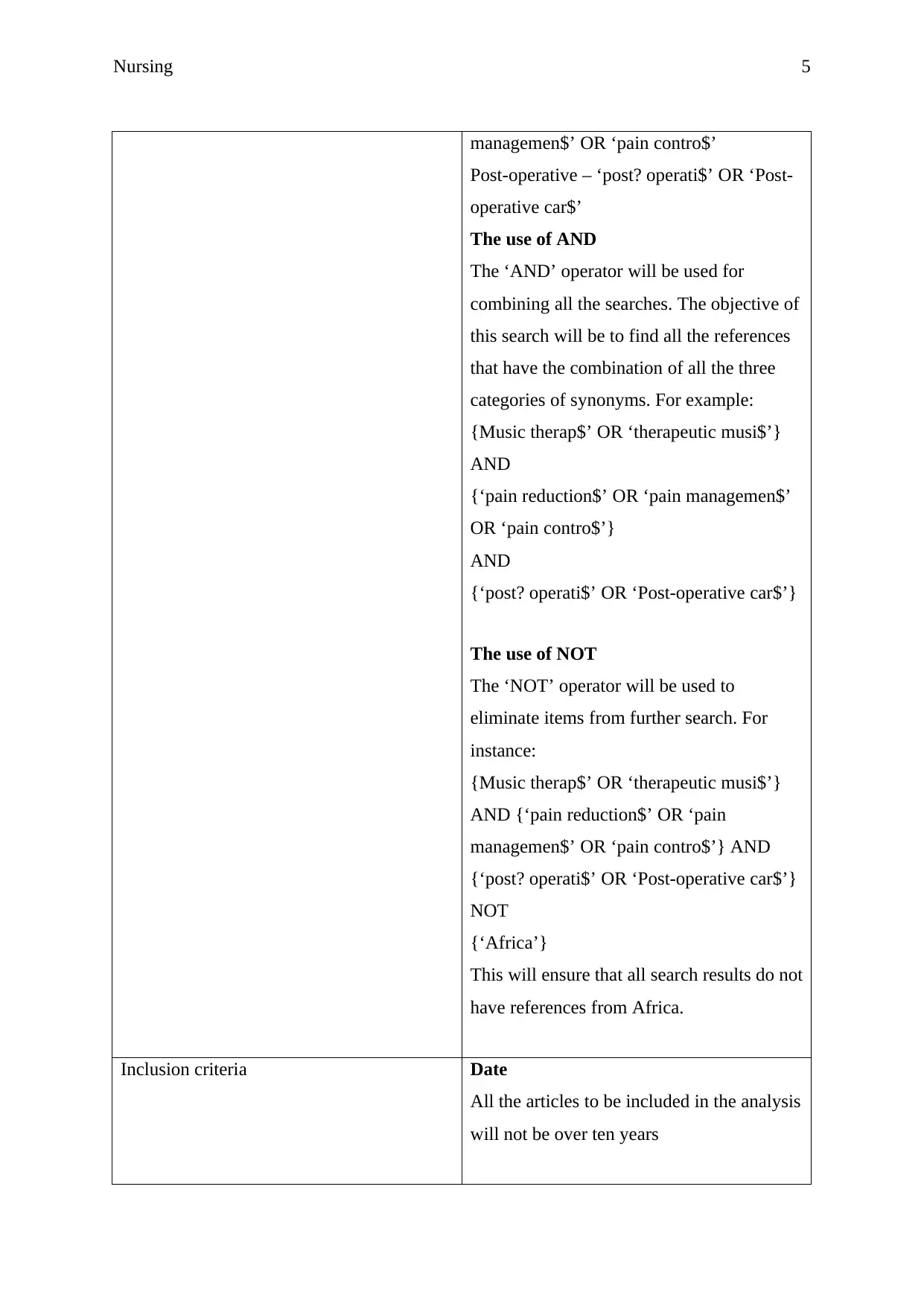
Nursing 5
managemen$’ OR ‘pain contro$’
Post-operative – ‘post? operati$’ OR ‘Post-
operative car$’
The use of AND
The ‘AND’ operator will be used for
combining all the searches. The objective of
this search will be to find all the references
that have the combination of all the three
categories of synonyms. For example:
{Music therap$’ OR ‘therapeutic musi$’}
AND
{‘pain reduction$’ OR ‘pain managemen$’
OR ‘pain contro$’}
AND
{‘post? operati$’ OR ‘Post-operative car$’}
The use of NOT
The ‘NOT’ operator will be used to
eliminate items from further search. For
instance:
{Music therap$’ OR ‘therapeutic musi$’}
AND {‘pain reduction$’ OR ‘pain
managemen$’ OR ‘pain contro$’} AND
{‘post? operati$’ OR ‘Post-operative car$’}
NOT
{‘Africa’}
This will ensure that all search results do not
have references from Africa.
Inclusion criteria Date
All the articles to be included in the analysis
will not be over ten years
managemen$’ OR ‘pain contro$’
Post-operative – ‘post? operati$’ OR ‘Post-
operative car$’
The use of AND
The ‘AND’ operator will be used for
combining all the searches. The objective of
this search will be to find all the references
that have the combination of all the three
categories of synonyms. For example:
{Music therap$’ OR ‘therapeutic musi$’}
AND
{‘pain reduction$’ OR ‘pain managemen$’
OR ‘pain contro$’}
AND
{‘post? operati$’ OR ‘Post-operative car$’}
The use of NOT
The ‘NOT’ operator will be used to
eliminate items from further search. For
instance:
{Music therap$’ OR ‘therapeutic musi$’}
AND {‘pain reduction$’ OR ‘pain
managemen$’ OR ‘pain contro$’} AND
{‘post? operati$’ OR ‘Post-operative car$’}
NOT
{‘Africa’}
This will ensure that all search results do not
have references from Africa.
Inclusion criteria Date
All the articles to be included in the analysis
will not be over ten years
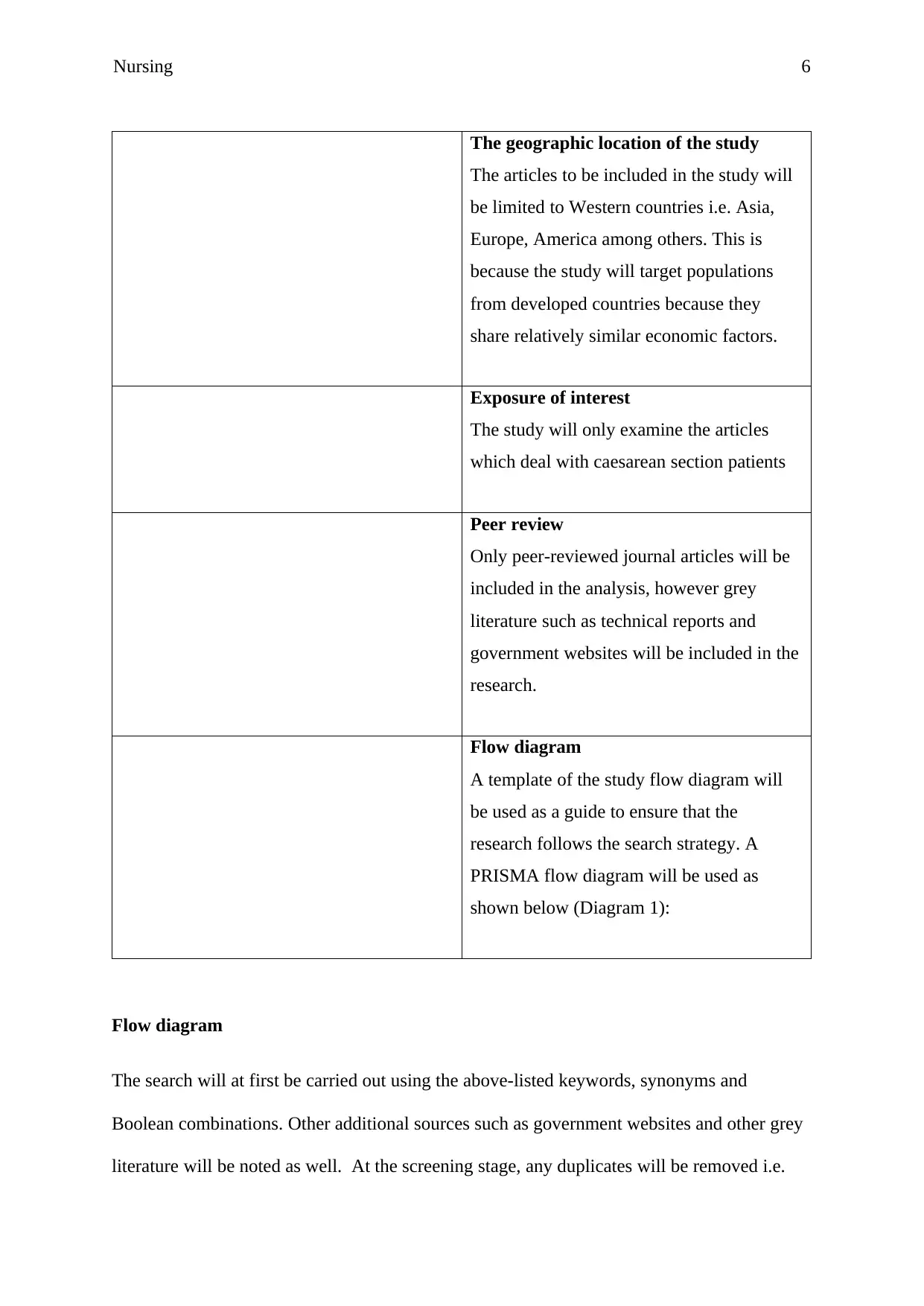
Nursing 6
The geographic location of the study
The articles to be included in the study will
be limited to Western countries i.e. Asia,
Europe, America among others. This is
because the study will target populations
from developed countries because they
share relatively similar economic factors.
Exposure of interest
The study will only examine the articles
which deal with caesarean section patients
Peer review
Only peer-reviewed journal articles will be
included in the analysis, however grey
literature such as technical reports and
government websites will be included in the
research.
Flow diagram
A template of the study flow diagram will
be used as a guide to ensure that the
research follows the search strategy. A
PRISMA flow diagram will be used as
shown below (Diagram 1):
Flow diagram
The search will at first be carried out using the above-listed keywords, synonyms and
Boolean combinations. Other additional sources such as government websites and other grey
literature will be noted as well. At the screening stage, any duplicates will be removed i.e.
The geographic location of the study
The articles to be included in the study will
be limited to Western countries i.e. Asia,
Europe, America among others. This is
because the study will target populations
from developed countries because they
share relatively similar economic factors.
Exposure of interest
The study will only examine the articles
which deal with caesarean section patients
Peer review
Only peer-reviewed journal articles will be
included in the analysis, however grey
literature such as technical reports and
government websites will be included in the
research.
Flow diagram
A template of the study flow diagram will
be used as a guide to ensure that the
research follows the search strategy. A
PRISMA flow diagram will be used as
shown below (Diagram 1):
Flow diagram
The search will at first be carried out using the above-listed keywords, synonyms and
Boolean combinations. Other additional sources such as government websites and other grey
literature will be noted as well. At the screening stage, any duplicates will be removed i.e.
⊘ This is a preview!⊘
Do you want full access?
Subscribe today to unlock all pages.

Trusted by 1+ million students worldwide
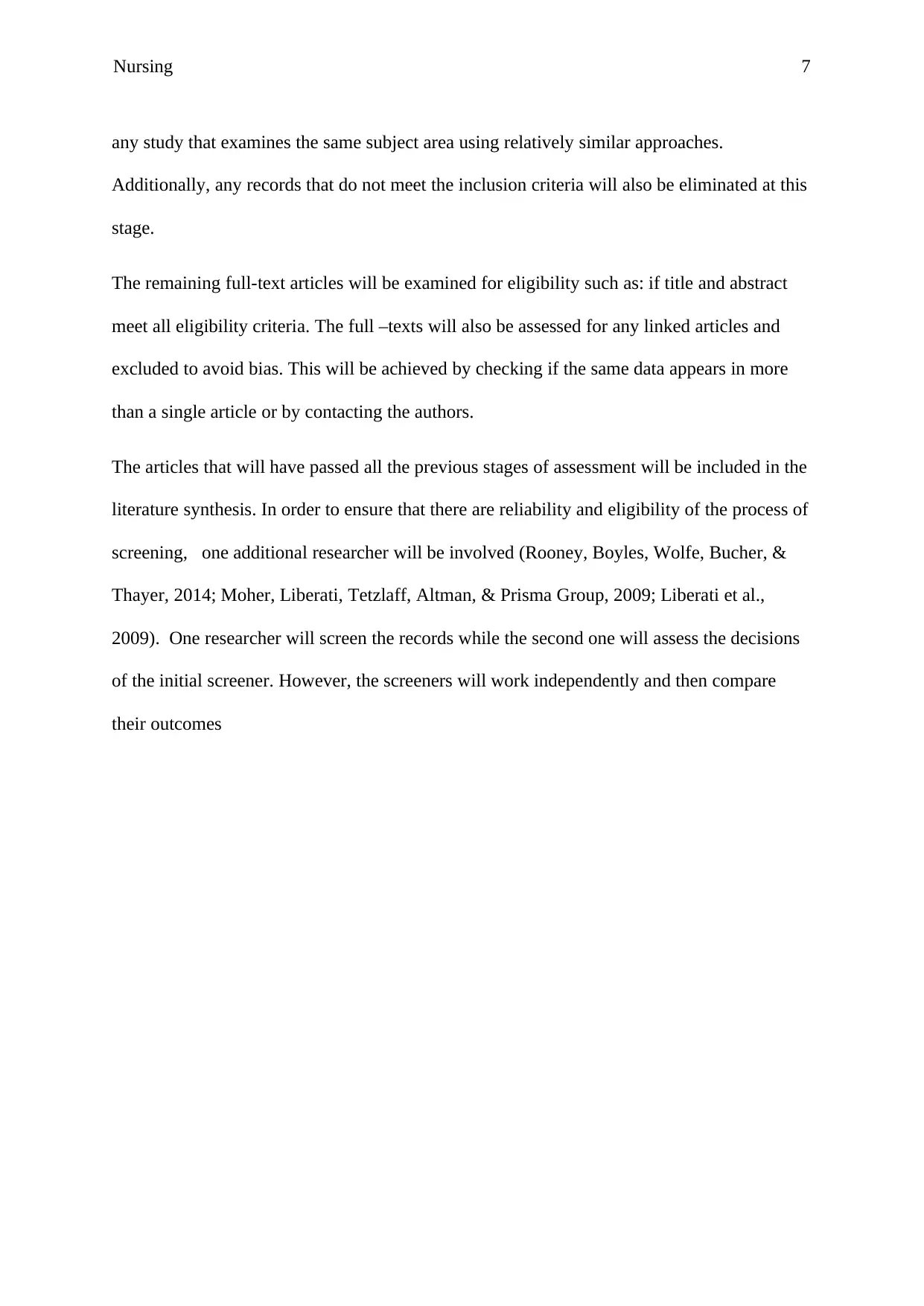
Nursing 7
any study that examines the same subject area using relatively similar approaches.
Additionally, any records that do not meet the inclusion criteria will also be eliminated at this
stage.
The remaining full-text articles will be examined for eligibility such as: if title and abstract
meet all eligibility criteria. The full –texts will also be assessed for any linked articles and
excluded to avoid bias. This will be achieved by checking if the same data appears in more
than a single article or by contacting the authors.
The articles that will have passed all the previous stages of assessment will be included in the
literature synthesis. In order to ensure that there are reliability and eligibility of the process of
screening, one additional researcher will be involved (Rooney, Boyles, Wolfe, Bucher, &
Thayer, 2014; Moher, Liberati, Tetzlaff, Altman, & Prisma Group, 2009; Liberati et al.,
2009). One researcher will screen the records while the second one will assess the decisions
of the initial screener. However, the screeners will work independently and then compare
their outcomes
any study that examines the same subject area using relatively similar approaches.
Additionally, any records that do not meet the inclusion criteria will also be eliminated at this
stage.
The remaining full-text articles will be examined for eligibility such as: if title and abstract
meet all eligibility criteria. The full –texts will also be assessed for any linked articles and
excluded to avoid bias. This will be achieved by checking if the same data appears in more
than a single article or by contacting the authors.
The articles that will have passed all the previous stages of assessment will be included in the
literature synthesis. In order to ensure that there are reliability and eligibility of the process of
screening, one additional researcher will be involved (Rooney, Boyles, Wolfe, Bucher, &
Thayer, 2014; Moher, Liberati, Tetzlaff, Altman, & Prisma Group, 2009; Liberati et al.,
2009). One researcher will screen the records while the second one will assess the decisions
of the initial screener. However, the screeners will work independently and then compare
their outcomes
Paraphrase This Document
Need a fresh take? Get an instant paraphrase of this document with our AI Paraphraser
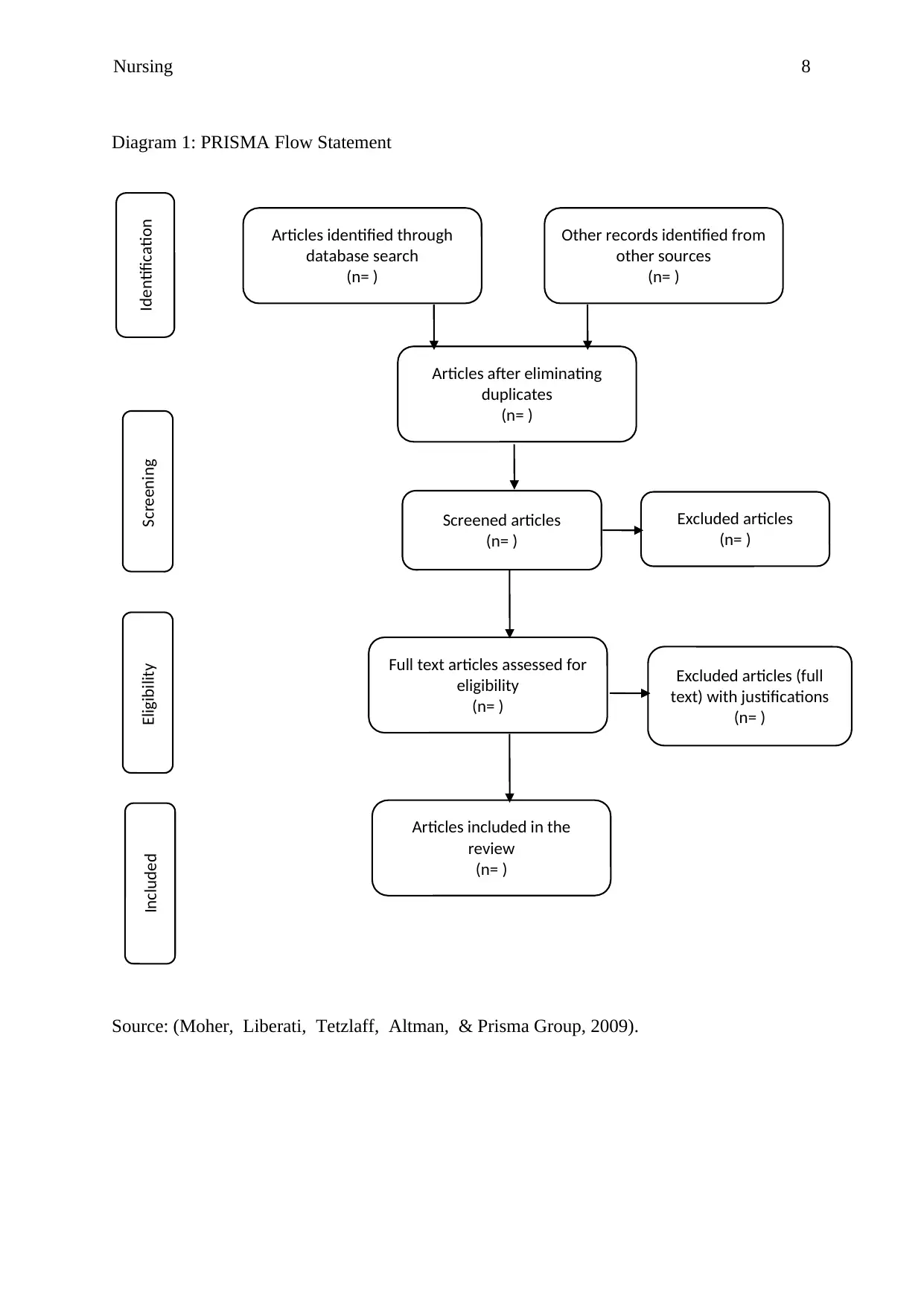
Nursing 8
Diagram 1: PRISMA Flow Statement
Source: (Moher, Liberati, Tetzlaff, Altman, & Prisma Group, 2009).
IdentificationScreeningEligibilityIncluded
Articles identified through
database search
(n= )
Other records identified from
other sources
(n= )
Articles after eliminating
duplicates
(n= )
Screened articles
(n= )
Excluded articles
(n= )
Full text articles assessed for
eligibility
(n= )
Excluded articles (full
text) with justifications
(n= )
Articles included in the
review
(n= )
Diagram 1: PRISMA Flow Statement
Source: (Moher, Liberati, Tetzlaff, Altman, & Prisma Group, 2009).
IdentificationScreeningEligibilityIncluded
Articles identified through
database search
(n= )
Other records identified from
other sources
(n= )
Articles after eliminating
duplicates
(n= )
Screened articles
(n= )
Excluded articles
(n= )
Full text articles assessed for
eligibility
(n= )
Excluded articles (full
text) with justifications
(n= )
Articles included in the
review
(n= )

Nursing 9
References
Echevarria, I. M., & Walker, S. (2014). To make your case, start with a PICOT
question. Nursing2018, 44(2), 18-19.
Hammer, P. L., & Rudeanu, S. (2012). Boolean methods in operations research and related
areas (7th ed.). Berlin, Germany: Springer Science & Business Media.
Liberati, A., Altman, D. G., Tetzlaff, J., Mulrow, C., Gøtzsche, P. C., Ioannidis, J. P., ... &
Moher, D. (2009). The PRISMA statement for reporting systematic reviews and meta-
analyses of studies that evaluate health care interventions: explanation and
elaboration. PLoS medicine, 6(7), e1000100.
Moher, D., Liberati, A., Tetzlaff, J., Altman, D. G., & Prisma Group. (2009). Preferred
reporting items for systematic reviews and meta-analyses: the PRISMA
statement. PLoS medicine, 6(7), e1000097.
Moher, D., Liberati, A., Tetzlaff, J., Altman, D. G., & Prisma Group. (2009). Reprint—
preferred reporting items for systematic reviews and meta-analyses: the PRISMA
statement. Physical therapy, 89(9), 873-880.
Orcher, L. T. (2016). Conducting research: Social and behavioral science methods (2nd ed.).
Abingdon,United Kingdom: Routledge.
Riva, J. J., Malik, K. M., Burnie, S. J., Endicott, A. R., & Busse, J. W. (2012). What is your
research question? An introduction to the PICOT format for clinicians. The Journal of
the Canadian Chiropractic Association, 56(3), 167-180.
References
Echevarria, I. M., & Walker, S. (2014). To make your case, start with a PICOT
question. Nursing2018, 44(2), 18-19.
Hammer, P. L., & Rudeanu, S. (2012). Boolean methods in operations research and related
areas (7th ed.). Berlin, Germany: Springer Science & Business Media.
Liberati, A., Altman, D. G., Tetzlaff, J., Mulrow, C., Gøtzsche, P. C., Ioannidis, J. P., ... &
Moher, D. (2009). The PRISMA statement for reporting systematic reviews and meta-
analyses of studies that evaluate health care interventions: explanation and
elaboration. PLoS medicine, 6(7), e1000100.
Moher, D., Liberati, A., Tetzlaff, J., Altman, D. G., & Prisma Group. (2009). Preferred
reporting items for systematic reviews and meta-analyses: the PRISMA
statement. PLoS medicine, 6(7), e1000097.
Moher, D., Liberati, A., Tetzlaff, J., Altman, D. G., & Prisma Group. (2009). Reprint—
preferred reporting items for systematic reviews and meta-analyses: the PRISMA
statement. Physical therapy, 89(9), 873-880.
Orcher, L. T. (2016). Conducting research: Social and behavioral science methods (2nd ed.).
Abingdon,United Kingdom: Routledge.
Riva, J. J., Malik, K. M., Burnie, S. J., Endicott, A. R., & Busse, J. W. (2012). What is your
research question? An introduction to the PICOT format for clinicians. The Journal of
the Canadian Chiropractic Association, 56(3), 167-180.
⊘ This is a preview!⊘
Do you want full access?
Subscribe today to unlock all pages.

Trusted by 1+ million students worldwide
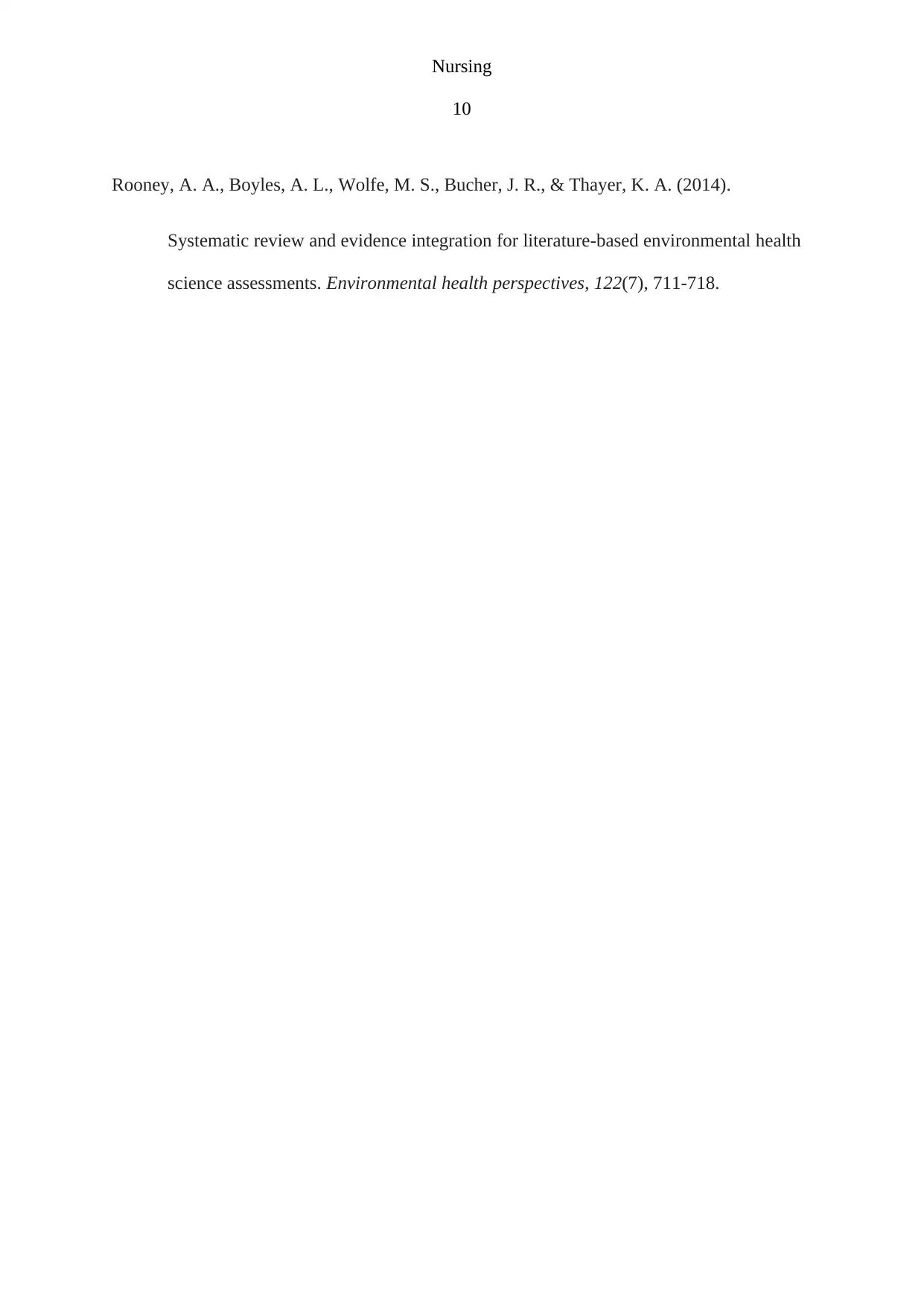
Nursing
10
Rooney, A. A., Boyles, A. L., Wolfe, M. S., Bucher, J. R., & Thayer, K. A. (2014).
Systematic review and evidence integration for literature-based environmental health
science assessments. Environmental health perspectives, 122(7), 711-718.
10
Rooney, A. A., Boyles, A. L., Wolfe, M. S., Bucher, J. R., & Thayer, K. A. (2014).
Systematic review and evidence integration for literature-based environmental health
science assessments. Environmental health perspectives, 122(7), 711-718.
1 out of 10
Related Documents
Your All-in-One AI-Powered Toolkit for Academic Success.
+13062052269
info@desklib.com
Available 24*7 on WhatsApp / Email
![[object Object]](/_next/static/media/star-bottom.7253800d.svg)
Unlock your academic potential
Copyright © 2020–2025 A2Z Services. All Rights Reserved. Developed and managed by ZUCOL.





